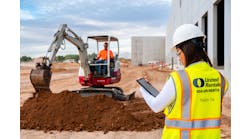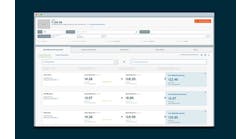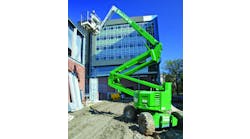Over the past several months, while in the Florida Keys, I've had a number of calls and emails regarding the aerial access market and what can be anticipated for 2009, 2010 and 2011. If history repeats, and if this industry follows as it has in the past three recessions, my prognostication is for some tough times in the aerial market at least through 2010. Here are my arguments:
-
There are a significant amount of high-cost finished goods available at all major manufacturers (JLG, Terex, Haulotte, Skyjack and, I suspect, Aichi, but that's unconfirmed).
-
Financing terms and warranties are now extended up to no interest or principal payments for 12 months. JLG has just announced a new 5-year warranty for domestic customers, which I anticipate will be extended globally as the market worsens. Global aerial access firms will want the same warranty treatment.
-
Major, regional and small rental companies will simply age their fleet, conserve cash, reduce non- to minimally profitable locations (as appropriate) and eliminate staff costs where possible, a process that is presently underway in the United States and the United Kingdom.
-
The past five years have been the best in history in the aerial markets and there is always an absorption/fleet integration/purchasing lag as the products funnel through to either the rental or direct sales chains.
-
Strengthening of the U.S. dollar on a global basis. This is already occurring and will continue and will impact domestic manufacturers with reduced sales outside North America and slow any real growth or rebound in the short term. Seventy percent of the aerial lifts produced are manufactured or assembled and shipped from North America with some imported components.
-
Reduced rental rates, reduced profits and sales at all the national/regional rental companies. This trend is evident throughout most of North America and Western Europe presently.
-
Significant decreases in selling prices of used equipment, which generally are sold before the manufacturers experience a sales upturn especially the commodity models (small battery-slab scissors, articulated booms to 45 feet and telescopic booms below 80 feet).
We should anticipate additional consolidation within the rental industry as there are some bargains available for strong-hearted, cash-rich entrepreneurs and/or hedge funds willing to ride out possibly 24+ months or so of tough times. Consolidation would definitely slow the upturn significantly, not only in North America but also Asia and Western Europe.
I don't foresee much consolidation within aerial manufacturers presently unless possibly Upright or Snorkel International are sold to Skyjack, Manitou or another independent group by the beleaguered Tanfield Group.
Oshkosh could certainly spin off JLG to reduce debt, but would take a monumental loss and finding a willing buyer at the moment would appear difficult. This would fit an acquisition by Caterpillar, but because of the Caterpillar Rental group, acquisition of JLG would impact potential sales to other major rental companies. Taking JLG public again also appears not to be a good option with the present market conditions. Terex spinning off Genie is remote; always a possibility but unlikely. However, this business group has provided substantial profits and sales volume for the parent Terex since its acquisition, along with much-needed sales expertise in the rental channel.
In any event, timing just isn't right at the moment. Toyota selling Aichi? That does not seem to make business sense nor do I think that will happen as the Aichi product line is becoming more intertwined with Toyota industrial products. Haulotte making another acquisition is a possibility but they are faced with a declining European market, especially Spain (a major market share stronghold). A weakened Euro could help sales in North America but reduce profitability and the need to minimize cash burn.
The aerial manufacturers have begun to respond to the sales downturn by eliminating staff in all areas. I anticipate the rightsizing will continue through at least the first half of 2009. A very moderate sales/shipment bump will be experienced in the first two quarters of 2009. The aerial-access companies should have positioned themselves to survive the next 12 months for minimal sales and shipments in the third and fourth quarters.
Will 2010 be a time of recovery? That still remains questionable and with a new Democratic President and Congress, many unanswered questions remain, especially the question of corporate and personal tax increases in the future. We have seen three states and New York City increase tax rates following the presidential election. Following the extremely critical stock market declines in October and continuing in November, even following a presidential election, the likelihood of a quick recession turnabout within the entire construction industry becomes more questionable and could possibly drag into 2010 or 2011. That will be devastating for the entire world construction equipment industry impacting the lifting and aerial/access segments. The industry may have to rethink and rewrite all business plans for the future, which is very unsettling.
An over-arching concern is the availability of funds from traditional industry lenders to finance new and used equipment purchases. More restrictive credit criteria could impact the ability of rental companies to increase their existing credit limits for new purchases, and their willingness to jump back into this market segment when rental rates along with profitability have experienced significant stress. This furthers the argument that the current downturn will last longer than the past two and be much slower in the climb out. This will have devastating results for the smaller “Tier 2” aerial-access manufacturers regardless of their positive rhetoric.
Unfortunately, the aerial-access industry globally is maturing, with no real hot regions or countries with the exception of the United Arab Emirates and potentially the U.K. for the upcoming Olympic Games. However even those countries can only absorb a certain number of existing units. As we slip deeper into recession, there will be the customary slowdown in new commercial and industrial facility engineering design, which will slow the business further. Auto makers will not be spending as that industry segment is dramatically slowing. The best the aerial access industry will possibly experience is a small bounce in 2010 and volume levels similar to 2004 in 2010.
Some manufactures won't be able to survive, especially the second-level minimal-volume producers and will likely disappear from the aerial access scene. This industry is facing some very interesting and difficult times for the next 24+ months.
This is not all doom and gloom as there are some very solid investing opportunities within the construction equipment industry. Here are several that should be considered as I would anticipate the savvy investor could double or triple his investment within five to seven years: United Rentals trading around a 52-week low; always solid with a good dividend Caterpillar; Manitowoc, a well-run company; Terex (I have great faith in Ron DeFeo and his operational skills); and John Deere, with a strong agricultural business group that will continue to grow with the alternative fuels market, should be added to an individual's portfolio.
Oshkosh is an attractive company, but there is risk because of its debt load and the possibility of Middle East military actions winding down, which would reduce some of its markets.
Frank Scarborough is the former president of Snorkel International and a veteran of more than 30 years in the aerial industry. He can be reached at [email protected].





